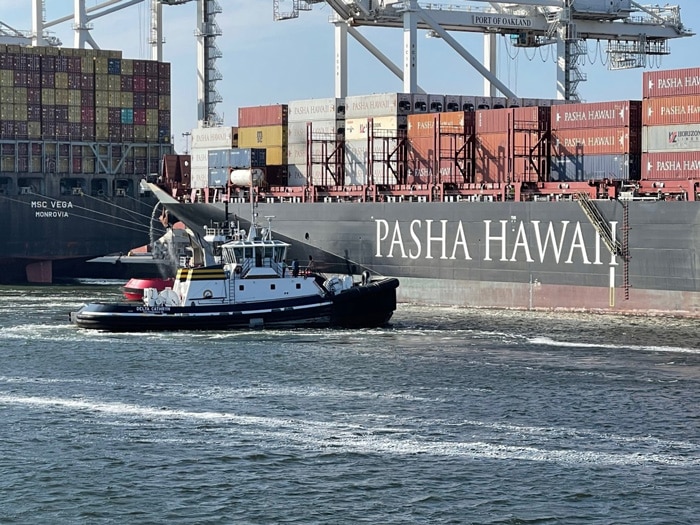
Op-Ed: Marine industry embraces sustainability with minimal impacts to capital budgets
Written by Heather Ervin
Alternative-fuel vessels and innovative finance solutions enable change
By Brandon Hannaman, senior vice president of equipment finance for Key Equipment Finance
Operating with fleets that meet current workloads are imperative for marine-industry companies, including commercial, workboat and marine construction companies. However, another standard that’s quickly becoming a common practice is outfitting fleets that meet current and future sustainability benchmarks – in an effort to reduce greenhouse gas emissions (GHG), maintain company reputation and prepare for upcoming regulations.

The International Maritime Organization’s (IMO) initial greenhouse gas (GHG) strategy plans to reduce the total GHG emissions by 50% or more by 2050 compared to 2008, and reduce the carbon intensity of international shipping by at least 40% by 2030 relative to 2008. Alternative-fueled vessels will play a key role in this environmental transition. For instance, vessels fueled by Liquefied Natural Gas (LNG) are significantly cleaner and better for the environment than traditional cargo liners.
Maritime companies are making large strides in the transition to zero-emission fuels over the next decade, and no one wants the burden or cost of stranded assets. The cost of fossil fuels is also expected to increase significantly as the industry moves toward alternative fuels-based vessels. Consider these market leaders:
- Van Oord recently procured three new-build trailing suction hopper dredges, which are built to be powered by dual fuel engines – one of the engines includes LNG;
- Maersk ordered six additional methanol-fueled, 17,000 TEU container ships as part of its decarbonization strategy, which includes a net-zero emissions target for 2040. The company also announced it will only order vessels that can be operated on green fuels;
- Pasha Hawaii added a 774-foot LNG fueled containership, and is adding a second LNG-fueled container ship, which will achieve energy efficiencies through a state-of-the-art engine, an optimized hull form and an underwater propulsion system with a high-efficiency rudder and propeller; and
- Crowley Maritime Corporation ordered a 416-foot LNG-powered bunker barge that will allow for delivery of LNG to various LNG containment systems as more of these vessels come into service.
Keeping up with the sustainable advances in maritime vessels can be a costly challenge for companies, and purchasing from capital budgets is not often feasible, or even possible. Many marine companies choose to finance vessels—including new construction and/or refurbished—which allows them to reap the benefits of an energy efficient fleet while maintaining the capital budget. Regardless of the type of vessel being considered, the main theme for 2023 is to plan ahead by researching options, determining an ideal financing structure and thoughtfully choosing a lender.
Pair Vessel Financing Structures to Organizational Objectives
Financing offers the opportunity for marine-industry companies to procure sustainable and environmentally-friendly vessels to power their business for years to come. Securing a proper financing structure for your fleet offers many advantages over purchasing outright. Here are some key financing considerations to be aware of:
- Due to inflation and supply issues, current asset values are higher than they were 12-18 months ago. As a direct result, many lenders are focused on advance rates on vessel financings, to ensure they aren’t over-advancing on vessels should values decrease in the next 12-24 months.
- Loan structures allow marine companies to capture depreciation benefits and offset taxable income. For new build projects lenders will look to advance up to 85% of build cost. On refinances or used vessels lenders will look to advance 85% of the Orderly Liquidation Value(s) (OLV).
- For longer terms with mission-appropriate amortization, all project costs—including sales tax, labor and freight—can be bundled into one plan, and include flexible payment options to meet owner requirements.
- By structuring true leases of vessels, lenders can offer fixed-price early buyout options for future purchase cost certainty.
- The marine industry continues to experience supply chain issues that delay construction of new vessels, thereby increasing risk, and some lenders won’t finance new builds.
- Choose a lender who has been active in marine-industry structured financing for more than 24 months, and one with strong industry knowledge and relationships.
Aligning with the right financing provider and terms may allow maritime organizations to reserve capital budgets and attain the vessels needed to address climate change and energy efficiency, while also gaining a competitive advantage in this substantial industry.
This document is designed to provide general information only and is not comprehensive nor is it legal, accounting or tax advice. KeyBank does not make any warranties regarding the results obtained from the use of this information. Credit products are subject to credit approval, terms, conditions, and availability and subject to change. Key Equipment Finance is a division of KeyBank. Key.com is a federally registered service mark of KeyCorp. ©2022 KeyCorp. All rights reserved.




